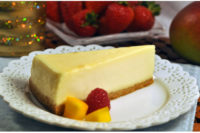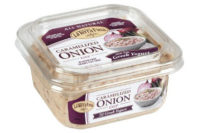The explosion of Greek-style has dominated the yogurt aisle for much of this year, including new introductions from Yoplait, Karoun Dairies, Dannon, Chobani and others.
This rapid growth in sales of Greek yogurt products is helping fuel growth in the overall yogurt category, according to Chicago-based Mintel. Retail sales of yogurt, including frozen products and yogurt drinks reached nearly $6.4 billion in 2011, up 7.5% from the year before, said Mintel. For instance, sales of Chobani brand Greek yogurts at food, drug and mass retailers (excluding Walmart) reached nearly $745 million in the 52 weeks ended May 13, 2012. That is a 105% increase from the year before, according to Mintel.
Norwich, N.Y.-based Chobani has proven to be a dominant player in the Greek yogurt market. “The Greek yogurt category is rising exponentially and we believe the yogurt story is just getting started in America,” said Lindsay Kos, communications manager for Chobani. “Americans don’t consume yogurt nearly as much as in other countries, and awareness of Greek yogurt’s benefits is still low. This provides tremendous room to play and grow the category.”
Expanding on its success, the company had several additions to its line this year, including three new flavors in 6-ounce cups — nonfat Apple Cinnamon, nonfat Blood Orange and low-fat Passion Fruit. For yogurt, these are “incredibly bold” flavors to find, said Kos. It’s a trend she’s seeing more with yogurt.
In its Chobani Champions line of Greek yogurt for children, the company introduced kid-friendly blended flavors of Vanilla Chocolate Chunk and Orange Vanilla. Also this year, Chobani Flip hit shelves in the Northeast region. Flip pairs low-fat Chobani with a side compartment of mix-ins, including two flavors for the regional launch — honey with banana and vanilla chocolate chip with raspberry.
Continuing its own mark in the Greek-style market, Dannon Co., White Plains, N.Y., dropped the Dannon name in favor of Oikos. Dannon added new flavors to its Oikos Greek yogurt and introduced the first-ever light Greek yogurt — Light & Fit Greek. According to Dannon, its portfolio of Greek yogurt is the fastest-growing in the industry. (Stonyfield Farms, partially owned by Dannon, sells an organic version of Oikos.)
General Mills’ Yoplaitdominated the yogurt aisle with several new additions to its line, including its own Greek contributions. It launched a 100-calorie Greek yogurt, which plays into the portion-control trend as well. Keeping the nutrition-minded consumer in mind, the company created a six-ingredient yogurt named Simplait. The company also introduced fat-free Greek yogurt with Nature Valley granola that you can mix in.
Greek outside the box
The Greek yogurt influence is beginning to show up in other cultured dairy products as well. Processors are using it as an ingredient in butter, smoothies, dips, cream cheeses and of course, freezing it. Greek yogurt is everywhere.
This summer, Alpharetta, Ga.-based Tryst Gourmet LLC, owner of Eat Well Enjoy Life, makers of non-chick pea hummus, created a hummus containing Greek yogurt. Franklin Foods, Enosburg Falls, Vt., owners of Greek Mountain Farms, launched a Greek yogurt cream cheese said to contain twice the protein and half the fat of regular cream cheese, plus live and active cultures. Along with Yoplait’s other introductions, it also added frozen smoothies with Greek yogurt to its line.
Dipping into diversity
From data collected by SymphonyIRI Group, Chicago, the cultured dairy segments (minus yogurt) saw minimal increases, but also minimal drops in dollar sales for the 52 weeks ended August 12, 2012 (see tables). In the cottage cheese category, sales were fairly stagnant (up 0.09%,) with units up 2.6%. The sour cream category fared a little better with dollar sales up 4% and units up 1.8%. Refrigerated dip sales were up 3.6%, but units dropped 1.5%. For the cream cheese category, brick-style saw the biggest jump in dollar sales up 8.3%, though units were down 3.4%.
A notable innovation in the cream cheese segment is Kraft’s Philadelphia Indulgence. The cream cheese spreads are available in 8-ounce tubs and cartons of 1.5-ounce individual cups. The flavor options — dark chocolate, milk chocolate and white chocolate — are described as a “new way to enjoy chocolate,” said Kraft. Indulgence is positioned as an afternoon snack or as an evening treat.
Despite stagnant sales, the trend toward innovation, portion-control and interesting flavor profiles is the focus for processors of sour cream, cream cheese, dips and cottage cheese.
According to Pete Kondrup, general manager for Westby Cooperative Creamery, Westby, Wis., there is a “give-me-more” trend blooming. “Consumers want taste, and more of it. Whether it’s more spice, more sweet, more savory, more fruity, more diversity; just make it tasty and give me lots of flavor choices,” he said.
Dairy dips are a good example, Kondrup said. Consumers are looking for spicy dips and yogurt-based dips, either regular or Greek.
Answering the call for more flavor was Heluva Good!, a brand of sour cream dips and cheeses from HP Hood, Lynnfield, Mass., which added a limited-edition sour cream dip flavor, Black Bean Queso, to its line this year.
Rising Sun Farms Inc., Phoenix, added a new flavor to its all-natural DipnSpread line — Thai Cilantro & Lime. The flavor is a combination of lemongrass, lime, cilantro and fresh ginger with a dash of coconut milk in a cream cheese base.
Portion-control and size options continue the trend toward convenience,
portability, pack-ability, and on-the-go; which means single-serve, said Kondrup.
This goes for all cultured dairy. Westby saw nice growth in its 6-ounce single-serve Low Fat Cottage Cheeses, especially in fruit flavors, said Kondrup.
Jay Allison, vice president of sales and marketing for Tillamook County Creamery Association, Tillamook, Ore., said the co-op has seen a trend in sour cream to control portion size with smaller containers.
Dairy nutrition is “in”
For Westby, the wellness trend means making sure consumers know what they are eating. “We recently redesigned our Single-Serve Cottage Cheese product line to include front-facing-callouts on ‘contains beneficial probiotic cultures’ and ‘a good source of protein & calcium,’” said Kondrup. “Also, the Thick-N-Creamy and Lite-N-Dreamy Yogurts now include a front-facing-callout on ‘no high fructose corn syrup,’” he added.
In addition, food manufacturers want healthy dairy nutrition as an ingredient in their food products, he said. Sour cream and yogurt are showing up in dips and spreads, and yogurt for smoothies, parfaits and frozen desserts.
Smith’s Dairy Products, owned by Dairy Enterprises Inc., Orrville, Ohio, focused on nutrition with its new Smith’s All Natural Sour Cream. It’s made with just two ingredients, milk and cream, with no preservatives, stabilizers or artificial ingredients.
Earlier in the year, Tillamook launched a new line of light yogurt that is the first on the market naturally sweetened with Truvia, a zero-calorie sweetener made from the stevia leaf.
Skyland Foods, Washington, D.C., is making nutrition its main focus with a new line of drinkable yogurts called IBEX. These dairy beverages come in four flavors; three with specific targeted nutrition goals — brain health, digestive health and body recovery. IBEX bottles are also grabbing attention. The striking black bottle features the ibex, a mountain-going animal. Brandon Partridge, CEO of Skyland, said the black packaging was designed to grab attention in the dairy case.
Another company putting nutrition front-and-center is Morton Grove, Ill.-based Lifeway. The company added several new functional kefir options to its line, including BioKefir — super-powered kefir shots. Each 3.5-ounce bottle contains 20 billion units of probiotic activity, which is twice the amount of probiotic power found in regular kefir. It also introduced Organic Green Kefir with Phytonutrients, which contains nutrients from 10 green vegetables and green tea. For smoothies it introduced Coconut Chia, emphasizing the natural omega-3s found in chia seeds.
As processors continue to see the health benefits cultured dairy can offer — from high-protein to fortification — the opportunities to grow the category can only get stronger.
Producers of Cultured Products Are Talking About:
• Greek-style yogurt
• Nutrition/fortification
• Bold flavors/flavor pairings
• Probiotics
• Smaller portion sizes and portability
• Foodservice opportunities
• Organic
Yogurt processors look to foodservice
Chobani opens yogurt bar
Chobani delved into foodservice with its first retail location, Chobani SoHo in New York City. A first-of-its-kind Mediterranean yogurt bar, it offers artisanal creations featuring chilled (but not frozen) plain Chobani as the base. Customers can try unique creations such as Pistachio + Chocolate (dark chocolate, clover honey, Turkish pistachios, fresh orange and mint) and Blueberry + Power (blueberries, walnuts, crunchy chia seeds, hemp seeds and light agave nectar).
Dannon gets personal
Dannon joined the foodservice bandwagon opening a new retail concept in New York City called The Yogurt Culture Company. The shop serves fresh plain yogurt that is made exclusively for the store. Customers determine the sweetener and how much they want, as well as toppings.
More yogurt is showing up on menus
By Mary Chapman, Technomic Inc.
While consumers’ favorite ice cream flavors are vanilla and chocolate, their favorite frozen yogurt and yogurt flavors are berry (66% prefer it), strawberry (64%), blueberry (62%), raspberry (62%) and cherry (61%).
Among the dishes featuring yogurt on the menus of the top chains, emerging concepts and leading independents, Technomic MenuMonitor finds the top flavors are strawberry (a descriptor on 29% of yogurt items), banana (23%), vanilla (16%), honey (12%) and blueberry (11%).
Technomic findings also reveal:
• The number of items featuring yogurt is up 7%, to 609 items in the second quarter of 2012 from 571 in the same period of 2011. The number restaurant concepts offering them are up 14%, to 179 from 157.
• The largest increases are in entrées (up 39%), add-ons (15%) and kids’ menus (43%). The largest category is in non-alcohol beverages, where incidence is flat.
• A look at health claims finds that 20% of items are described as non-fat, 14% as low-fat, 11% as fat-free, 6% as natural, and 5% as organic.
• New items include the Apple Slices & Yogurt Dip offered as a side at Arby’s; Jason’s Deli’s Yogurt Fruit & Crunch Parfait Cup with vanilla yogurt, strawberries, bananas, grapes and organic apples layered with organic granola; and Atlanta’s Doc Chey’s Noodle House added Indian Curry Salad with steamed broccoli, bean sprouts, carrot, peanuts and pickled cucumber topped with creamy curried yogurt dressing over brown rice.
• MenuMonitor finds only 15 instances of “Greek yogurt” on menus in second-quarter 2012. That equates to about 2.5% of yogurt items.
Analysis on other cultured dairy products finds:
• Sour cream is named in the menu descriptions of 1,645 items in second quarter 2012, up 6% over 2011. The number of entrées with sour cream is up 7%, to 983 from 922. Fully 67% of these entrées are Mexican dishes. Items that are not Mexican include Souper Salad’s Ham and Macaroni Salad and Tuna Skoodle Pasta Salad, both of which have sour cream in the dressing.
• Buttermilk is in 737 items, up 4% from 708 in 2011. Buttermilk is found almost exclusively describing pancakes, ranch dressing, fried chicken or biscuits. The increase number is likely related to the latter, as the number of breakfast sandwiches increased 35% at limited-service restaurants within the Top 500 restaurant chains.
• Cottage cheese saw an increase of 12%, to 308 items in second-quarter 2012 from 274 in the prior year. It is mostly menued as a side item, though not at more chains (the number, 38, was flat year-over-year), but alongside more items.
— Mary Chapman is the director of product innovation
at Technomic Inc., Chicago.


















